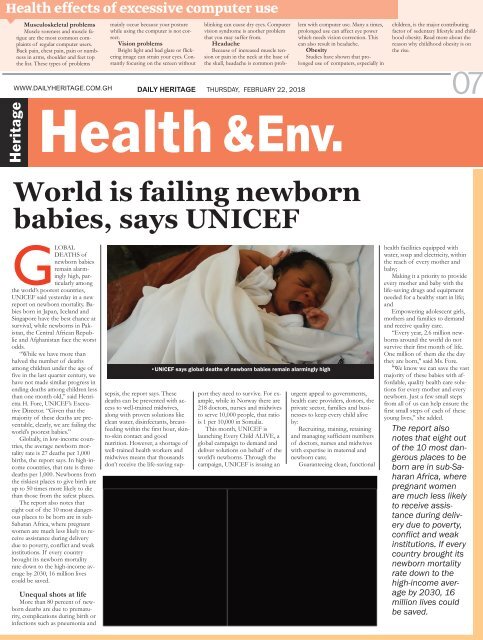February 22
Create successful ePaper yourself
Turn your PDF publications into a flip-book with our unique Google optimized e-Paper software.
Inside <strong>February</strong> <strong>22</strong>, 2018 .qxp_Layout 1 2/21/18 6:48 PM Page 6<br />
Health effects of excessive computer use<br />
Musculoskeletal problems<br />
Muscle soreness and muscle fatigue<br />
are the most common complaints<br />
of regular computer users.<br />
Back pain, chest pain, pain or numbness<br />
in arms, shoulder and feet top<br />
the list. These types of problems<br />
mainly occur because your posture<br />
while using the computer is not correct.<br />
Vision problems<br />
Bright light and bad glare or flickering<br />
image can strain your eyes. Constantly<br />
focusing on the screen without<br />
blinking can cause dry eyes. Computer<br />
vision syndrome is another problem<br />
that you may suffer from.<br />
Headache<br />
Because of increased muscle tension<br />
or pain in the neck at the base of<br />
the skull, headache is common problem<br />
with computer use. Many a times,<br />
prolonged use can affect eye power<br />
which needs vision correction. This<br />
can also result in headache.<br />
Obesity<br />
Studies have shown that prolonged<br />
use of computers, especially in<br />
children, is the major contributing<br />
factor of sedentary lifestyle and childhood<br />
obesity. Read more about the<br />
reason why childhood obesity is on<br />
the rise.<br />
WWW.DAILYHERITAGE.COM.GH<br />
DAILY HERITAGE THURSDAY, FEBRUARY <strong>22</strong>, 2018<br />
&Env.<br />
World is failing newborn<br />
babies, says UNICEF<br />
GLOBAL<br />
DEATHS of<br />
newborn babies<br />
remain alarmingly<br />
high, particularly<br />
among<br />
the world’s poorest countries,<br />
UNICEF said yesterday in a new<br />
report on newborn mortality. Babies<br />
born in Japan, Iceland and<br />
Singapore have the best chance at<br />
survival, while newborns in Pakistan,<br />
the Central African Republic<br />
and Afghanistan face the worst<br />
odds.<br />
“While we have more than<br />
halved the number of deaths<br />
among children under the age of<br />
five in the last quarter century, we<br />
have not made similar progress in<br />
ending deaths among children less<br />
than one month old,” said Henrietta<br />
H. Fore, UNICEF’s Executive<br />
Director. “Given that the<br />
majority of these deaths are preventable,<br />
clearly, we are failing the<br />
world’s poorest babies.”<br />
Globally, in low-income countries,<br />
the average newborn mortality<br />
rate is 27 deaths per 1,000<br />
births, the report says. In high-income<br />
countries, that rate is three<br />
deaths per 1,000. Newborns from<br />
the riskiest places to give birth are<br />
up to 50 times more likely to die<br />
than those from the safest places.<br />
The report also notes that<br />
eight out of the 10 most dangerous<br />
places to be born are in sub-<br />
Saharan Africa, where pregnant<br />
women are much less likely to receive<br />
assistance during delivery<br />
due to poverty, conflict and weak<br />
institutions. If every country<br />
brought its newborn mortality<br />
rate down to the high-income average<br />
by 2030, 16 million lives<br />
could be saved.<br />
Unequal shots at life<br />
More than 80 percent of newborn<br />
deaths are due to prematurity,<br />
complications during birth or<br />
infections such as pneumonia and<br />
•UNICEF says global deaths of newborn babies remain alarmingly high<br />
sepsis, the report says. These<br />
deaths can be prevented with access<br />
to well-trained midwives,<br />
along with proven solutions like<br />
clean water, disinfectants, breastfeeding<br />
within the first hour, skinto-skin<br />
contact and good<br />
nutrition. However, a shortage of<br />
well-trained health workers and<br />
midwives means that thousands<br />
don’t receive the life-saving support<br />
they need to survive. For example,<br />
while in Norway there are<br />
218 doctors, nurses and midwives<br />
to serve 10,000 people, that ratio<br />
is 1 per 10,000 in Somalia.<br />
This month, UNICEF is<br />
launching Every Child ALIVE, a<br />
global campaign to demand and<br />
deliver solutions on behalf of the<br />
world’s newborns. Through the<br />
campaign, UNICEF is issuing an<br />
urgent appeal to governments,<br />
health care providers, donors, the<br />
private sector, families and businesses<br />
to keep every child alive<br />
by:<br />
Recruiting, training, retaining<br />
and managing sufficient numbers<br />
of doctors, nurses and midwives<br />
with expertise in maternal and<br />
newborn care;<br />
Guaranteeing clean, functional<br />
health facilities equipped with<br />
water, soap and electricity, within<br />
the reach of every mother and<br />
baby;<br />
Making it a priority to provide<br />
every mother and baby with the<br />
life-saving drugs and equipment<br />
needed for a healthy start in life;<br />
and<br />
Empowering adolescent girls,<br />
mothers and families to demand<br />
and receive quality care.<br />
“Every year, 2.6 million newborns<br />
around the world do not<br />
survive their first month of life.<br />
One million of them die the day<br />
they are born," said Ms. Fore.<br />
"We know we can save the vast<br />
majority of these babies with affordable,<br />
quality health care solutions<br />
for every mother and every<br />
newborn. Just a few small steps<br />
from all of us can help ensure the<br />
first small steps of each of these<br />
young lives,” she added.<br />
The report also<br />
notes that eight out<br />
of the 10 most dangerous<br />
places to be<br />
born are in sub-Saharan<br />
Africa, where<br />
pregnant women<br />
are much less likely<br />
to receive assistance<br />
during delivery<br />
due to poverty,<br />
conflict and weak<br />
institutions. If every<br />
country brought its<br />
newborn mortality<br />
rate down to the<br />
high-income average<br />
by 2030, 16<br />
million lives could<br />
be saved.

















